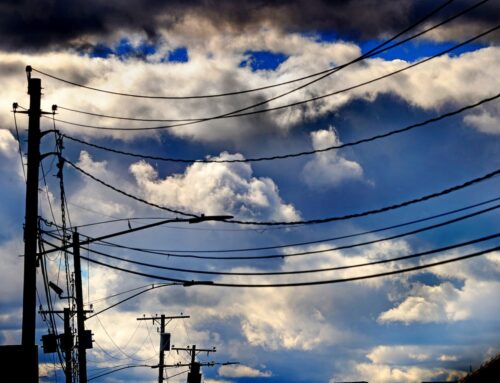A Clean-Energy Boom Could Be Built on Oil and Gas Technology
April 4, 2025
The United States is in the midst of an energy revolution. Under the Biden administration, the country shoveled unprecedented sums of federal dollars into clean-energy projects—battery factories, solar farms, nuclear plants—while also producing and exporting record volumes of oil and gas. President Donald Trump has vowed to ramp up energy production further, but takes a skeptical view of solar and wind power. But Trump’s “Drill, baby, drill” mantra extends beyond fossil fuels. His administration is embracing geothermal energy, which is primed for a very American boom.
In the United States, geothermal energy, which uses the Earth’s heat to create electricity, supplies less than half of 1 percent of the country’s electricity, but few other clean-energy sources offer as much promise right now. Many climate activists support geothermal energy as a renewable power source that generates zero-carbon electricity. A recent report from the Rhodium Group, an energy-research firm, projected that geothermal could meet as much as 64 percent of new electricity demand from data centers by the early 2030s. America is far behind rivals such as China and Russia in manufacturing solar panels or building nuclear plants. But geothermal makes use of an area of the U.S. industrial base that has grown in recent years—oil and gas production.
Cindy Taff, whose company, Sage Geosystems, is anticipating geothermal’s potential growth, told me about a recent drive she took through southern Texas that illustrated that overlap. “The same drilling rig that drilled our well in September was on a lease right off the highway drilling an oil-and-gas well,” she said, laughing. “It’s just the same.”
Taff came from the oil industry: She was once a vice president at Royal Dutch Shell who commanded a team of 350 employees using hydraulic fracturing (better known as fracking) to drill their way through five countries’ bedrock. Fracking had driven an oil-and-gas boom starting in the mid-2000s, and her team had looked at using the same technique to tap the Earth’s underground heat. At Shell, “we never actually drilled wells” to try it on geothermal energy, she told me. “It was frustrating.” The opportunity looked big enough to her that she started Sage.
Much like oil and gas, geothermal energy, which harnesses the planet’s molten core to make steam, had long been confined to the places where access came easy—the American West, where Yellowstone’s famous geysers hint at the heat below, or volcanic Iceland. In those places—generally volcanic hot spots where magma flows at shallow depths in the Earth’s crust and underground water reservoirs—geothermal energy can be a substantial source of power. Currently, it provides roughly 10 percent of Nevada’s electricity generation and as much as 5 percent of the power California produces; Iceland generates 30 percent of its electricity, and Kenya nearly half, from geothermal. Traditional coal or nuclear plants generate heat to turn water into steam, which spins turbines to make electricity. Geothermal power stations do the same using hot water from underground reservoirs.
Sage uses fracking technology to crack open hot rocks even deeper underground, enabling access to heat in more locations. The company’s drillers then inject water into the well, prying open the stone fissures and creating an artificial reservoir. When Sage releases that water, the pressure from underground shoots it upward, and the heat creates vapors that spin turbines and crank out electricity. This system can also serve as storage for weather-dependent wind and solar: Extra electricity from turbines and panels can pump water into Sage’s wells that can be released later to produce electricity.
Sage expects to have its first energy-storage facility up and running in Texas in the coming weeks, but already has a deal to sell power to Meta’s data centers. And a similar start-up, Fervo Energy, demonstrated that it could use fracking technology to successfully produce 24/7 carbon-free energy back in 2023, at a pilot project in Nevada.
Geothermal does have certain advantages compared with other sources of renewable energy. Solar and wind need large areas of land, huge volumes of minerals, and a massive new network of transmission lines. (Plus, China dominates those industries’ supply chains.) Hydroelectric dams are less dependable in a world where water is growing scarcer and precipitation harder to forecast. Nuclear reactors cost billions of dollars and take years to build; the U.S. depends heavily on counties such as Canada, Kazakhstan, and Russia for uranium fuel, and has yet to establish the infrastructure to either permanently store or recycle nuclear waste.
For now, most of the efforts to debut next-generation geothermal technology are still in the American West, where drilling is relatively cheap and easy because the rocks they’re targeting are closer to the surface. But if the industry can prove to investors that its power plants work as described—which experts expect to happen by the end of the decade—geothermal could expand quickly, just like oil-and-gas fracking did.
That the “enhanced” geothermal industry piggybacks on technology from the fossil-fuel industry also puts it in a position to grow. “In the U.S., our manufacturing base is falling apart. But we have a ridiculously good industrial base in oil and gas,” Charles Gertler, who until recently worked at the Energy Department’s Loan Programs Office and co-authored a report outlining a pathway for the industry’s growth, told me. “The fact that you can just rely on many of the same tools and people and technologies and supply chains is the reason a lot of folks are so excited.” Investors have been cool on the industry since a handful of conventional geothermal projects went under two decades ago. But Gertler estimated that, if five to 10 new geothermal projects prove successful, banks will open their wallets again.
Unlike other renewable-energy sources, the emerging geothermal sector has received little direct support from the federal government. By the time Fervo had demonstrated it could frack for geothermal energy, the Biden administration had already passed two monumental climate-spending laws, which directed billions of dollars toward technologies such as solar, wind, and nuclear power, but just $84 million for early-stage geothermal. Companies such Fervo and Sage could still benefit, though, from tax credits for producing zero-carbon electricity, if Republicans in Congress don’t repeal key parts of Biden’s Inflation Reduction Act.
“I don’t know where that’s going,” Representative Celeste Maloy, the Utah Republican in whose district Fervo is building its first large-scale plant, told me. But she said slashing the requirements for obtaining federal permits—which her party is eager to do—could give the industry enough of a boost that “it almost doesn’t matter what happens to the IRA incentives.” (No company has made that case to her, she allowed.)
Like any energy industry, geothermal has external costs that could become bigger issues as it grows. In 2017, an early experiment in enhanced geothermal energy in South Korea triggered a serious earthquake. (Earthquakes doubled in Texas in 2021 thanks to oil and gas companies injecting sludgy wastewater into underground wells.) Locations with particularly good hot-rock resources could end up overlapping with threatened species, just as one of the nation’s biggest lithium projects ran up against an endangered wildflower or one of California’s largest solar farms put tortoises at risk. Environmentalists primed to see anything with Big Oil’s fingerprints on it as suspicious will find plenty of connections between this industry and fossil-fuel companies. And, as the industry scales up, it will use larger volumes of water.
Fervo, for one, has been pushing to use water too brackish for agricultural or municipal purposes, Tim Latimer, Fervo’s chief executive, told me: “So we’re not really fighting with people over water even though we’re in the western desert.” Other companies, such as XGS Energy, are boring more conventional wells and keeping water contained in closed-loop pipes, eliminating the risk of losing any water at all in the process.
Electricity has to come from somewhere, though, and as demand surges, the Trump administration is winning over support even from some Democrats to keep coal plants open longer. Meanwhile, gas power plants are expanding. To keep the lights on—while keeping utility bills and global temperatures down as much as possible—the country will need to employ all available resources of clean power, and perhaps especially those the current administration is willing to support.
Search
RECENT PRESS RELEASES
Related Post


